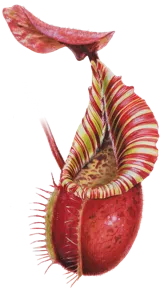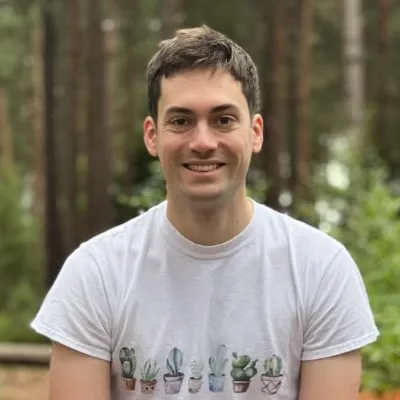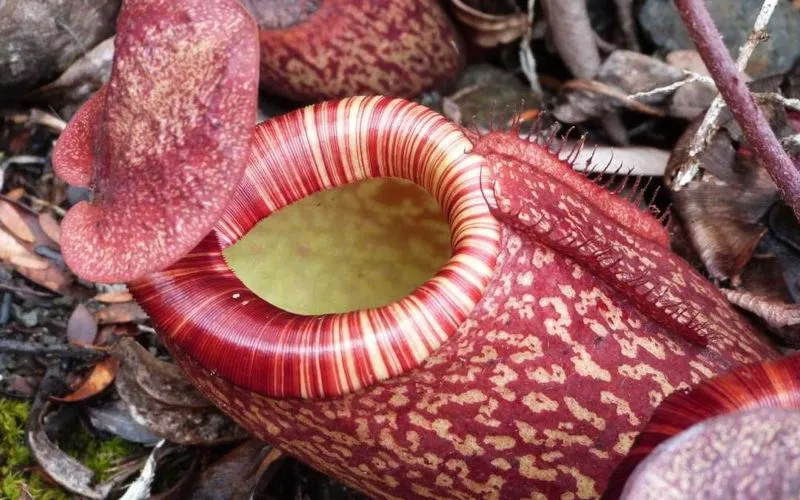Today I’m very excited to publish the first in what I hope will be a series of new posts I’m calling the Species Showcases. To kick things off, we’ll be looking at Nepenthes peltata in this incredible article written by Francis Bauzon.
I first had the pleasure of talking to Francis after he contributed the photos for my article on Native Exotics. Based in San Diego, Francis is behind the one of the most niche CP accounts I’ve yet discovered: peltata_man69. Francis has kindly put together this detailed look at his favourite species, exploring everything from pitcher morphology to common clones, cultivation to hybridisation. Enjoy!
Be sure to subscribe to Tom’s Carnivores for more articles like this.
Thanks, and enjoy.
Jump to…
From my very first foray into carnivorous plants in early 2016, I have been fascinated by Nepenthes peltata. I can’t explain why exactly this species out of all the Nepenthes caught my attention—perhaps it’s the colorful leaves and large striped pitchers, or its dense hairs, or its odd peltate tendril insertion, or the fact that it’s from the Philippines where my family is from—but it is certainly not the only species that has these characteristics. Either way, it has become my favorite species and I would like to share a bit of what I have learned about it both from reading and personal observation.
1. Description
N. peltata is endemic to a single mountain on the island of Mindanao in the Southern Philippines, where it grows from 865 masl to the summit at 1635 masl. As its name suggests, the pitcher bearing tendrils on this species are attached to the leaf not at the very end of the leaves, but just before it, causing a dimple in the leaf where the attachment occurs. Actually, many Nepenthes species display this trait to small degree at maturity, but N. peltata is distinct in that this characteristic is particularly exaggerated, just as it is in N. rajah and N. clipeata.
Click on any photo to zoom in. Use arrow keys or swipe to navigate.
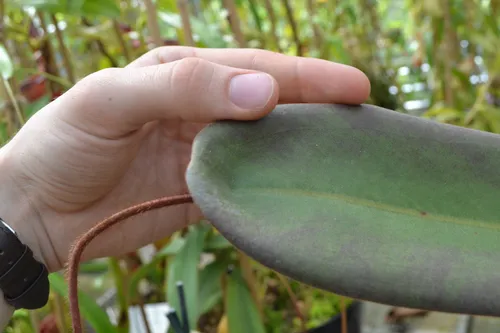 01. The peltate tendril insertion
01. The peltate tendril insertion 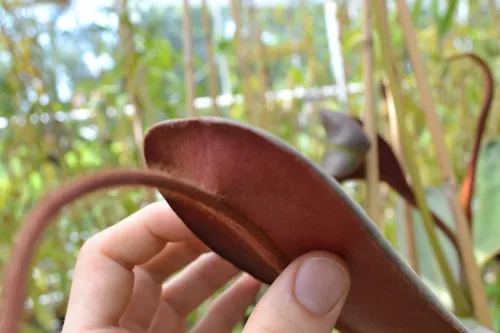 02. The peltate tendril insertion
02. The peltate tendril insertion Leaves
The leaves on N. peltata are generally oblong and petiolate, and covered with an indumentum of brown hairs on the petioles, undersides, margins, and tendrils, which is especially pronounced on developing leaves.
N. peltata has variable leaf color, ranging from green to dark red, and this applies both to the upper surface and underside of the leaves. Many clones have a saturated red color on the leaf undersides - in fact, in my observation, most clones in cultivation seem to have this trait, while in-situ photographs seem to show a higher proportion of totally green individuals.
Click on any photo to zoom in. Use arrow keys or swipe to navigate.
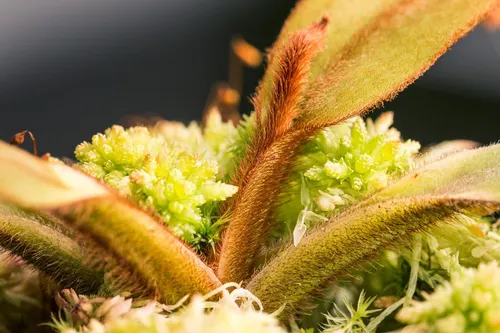 03. A Native Exotics clone with all parts of the leaves displaying an indumentum to some degree
03. A Native Exotics clone with all parts of the leaves displaying an indumentum to some degree 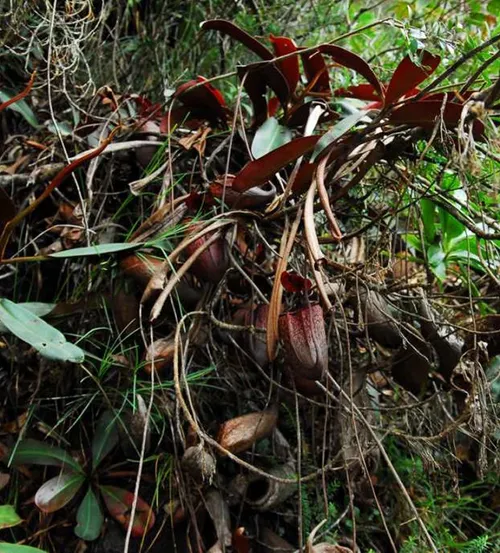 04. "Red Phantom" showing red leaf undersides
04. "Red Phantom" showing red leaf undersides 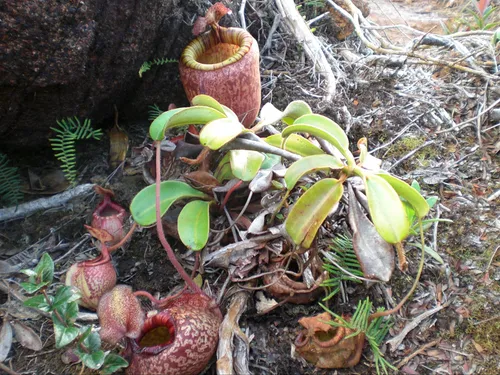 05. A totally green individual
05. A totally green individual 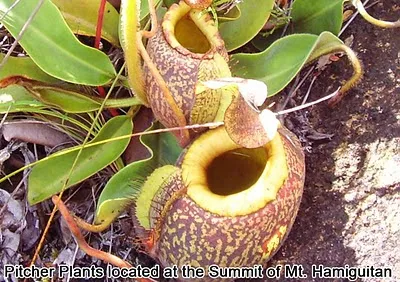 06. Totally green leaves, despite presumably growing exposed at the summit of Mt. Hamiguitan
06. Totally green leaves, despite presumably growing exposed at the summit of Mt. Hamiguitan This difference in leaf color appears to be genetic, and is not dependent on light levels. In my personal collection, many clones are totally green while others have pink to blood red undersides under the same lighting conditions.
Tendril Insertion
The characteristic peltate tendril insertion of this species tends not show until the plant has attained some size, and certainly not at seedling size. This trait also seems sensitive to the stability of one’s growing conditions. I have several plants that were peltate when they were received, but have become less so or not peltate at all in response to a change in conditions - even with a ~10” leafspan. On the other hand, I have some plants that were strongly peltate even at a small size (~6”) and have remained so. In my opinion, for the vast majority of hobbyists growing small to medium sized plants, the presence or absence of a peltate tendril insertion is a poor diagnostic for “purity”. It is best to simply give the plant time to develop this characteristic under stable conditions.
Click on any photo to zoom in. Use arrow keys or swipe to navigate.
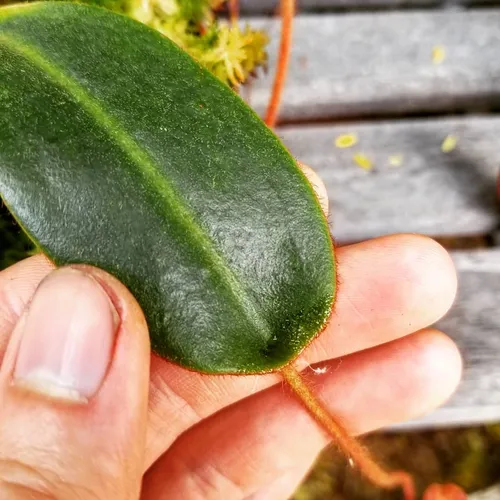 07. Peltate leaf on a young plant, by Francis Bauzon
07. Peltate leaf on a young plant, by Francis Bauzon 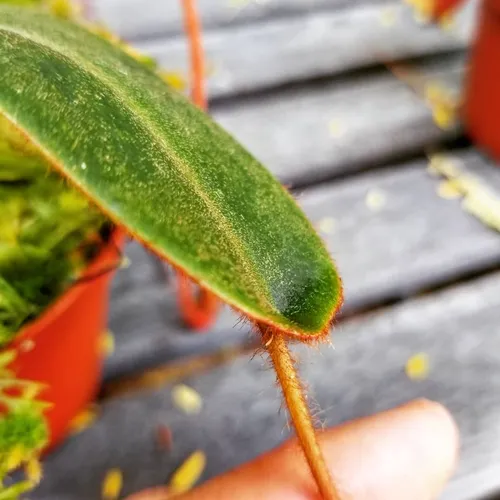 08. Peltate leaf on a young plant, by Francis Bauzon
08. Peltate leaf on a young plant, by Francis Bauzon Pitcher Morphology
Peristome
N. peltata has a slightly variable peristome, but it is generally striped. The stripes can be fine and low-contrast and they can be bold and showy. Regardless, the peristome tends to darken with age. The peristome can also be crenellated to varying degrees, but not always. The rear of the peristome can be raised to form a neck, where it meets the operculum.
Click on any photo to zoom in. Use arrow keys or swipe to navigate.
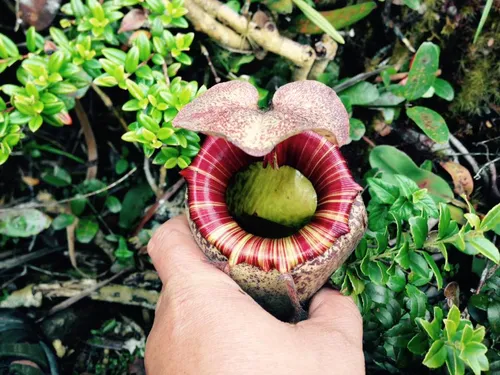 09. By Alfred Yray Ramos
09. By Alfred Yray Ramos 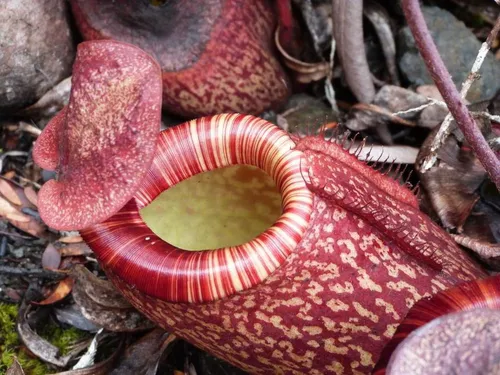 10. By Mark Rouse
10. By Mark Rouse 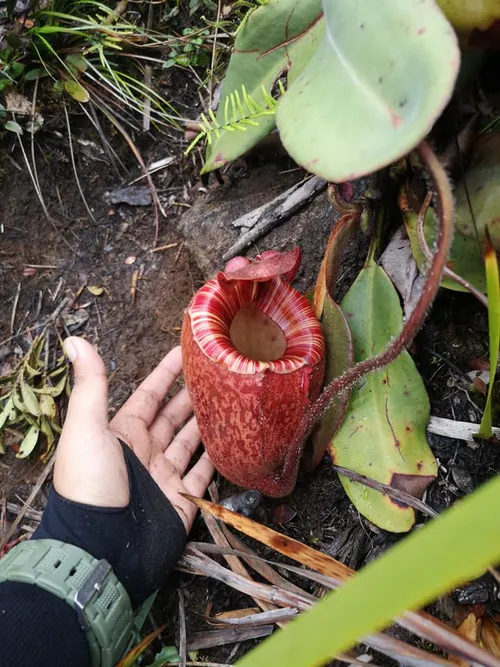 11. By Dak Java Comidoy
11. By Dak Java Comidoy 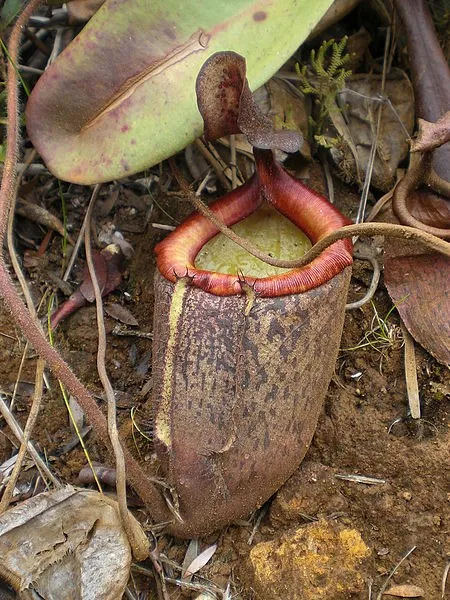 12. By Kleo Marlo Sialongo
12. By Kleo Marlo Sialongo 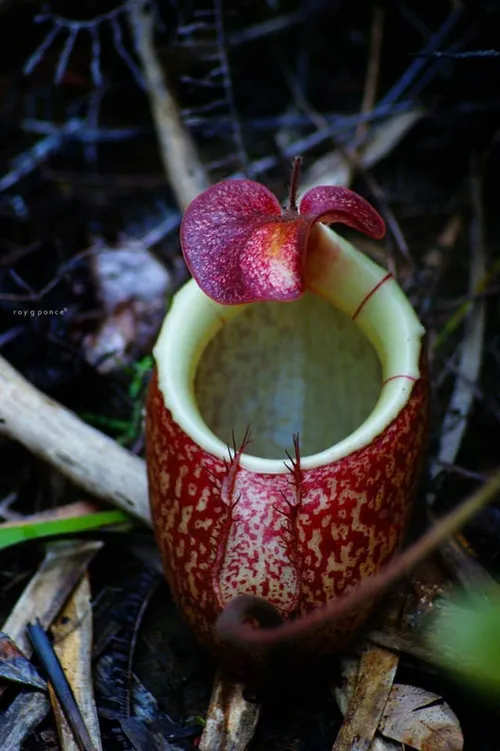 13. By Roy Ponce
13. By Roy Ponce Operculum (lid)
One aspect of N. peltata’s pitcher morphology that is rarely brought up is the shape of its lid, which is described as being ovate (broadest at the base) to elliptical. In my observation of in-situ photographs as well as photos of cultivated plants, the majority of N. peltata have ovate lids with one additional detail - the end of the lid is truncated, so as to make a roughly rectangular or trapezoidal shape.
Additionally, many N. peltata exhibit conspicuous nectar glands and tend to have a prominent basal crests as well.
Click on any photo to zoom in. Use arrow keys or swipe to navigate.
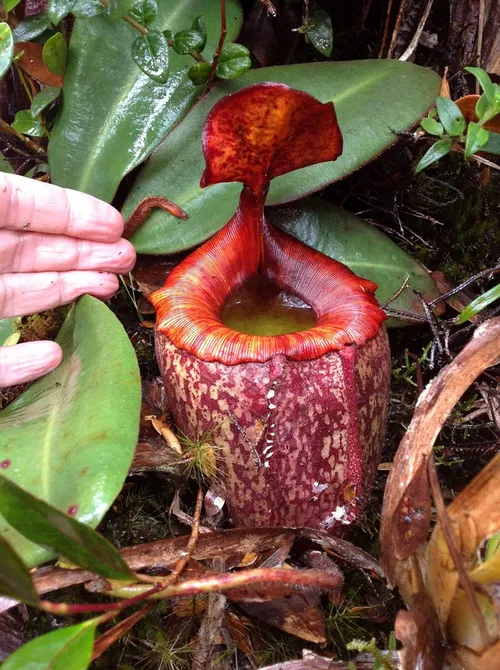 14. By Alastair Robinson
14. By Alastair Robinson 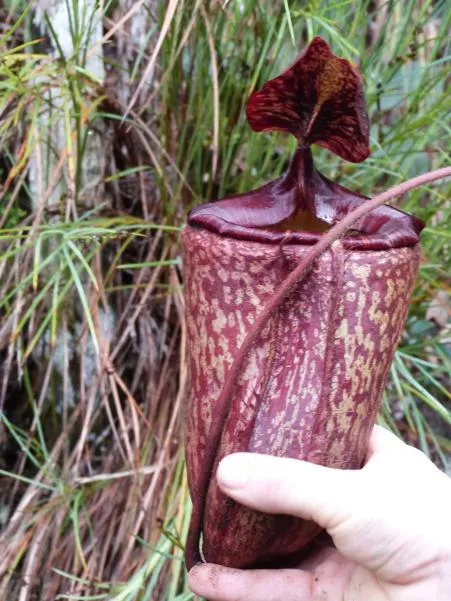 15. By Mark Rouse
15. By Mark Rouse 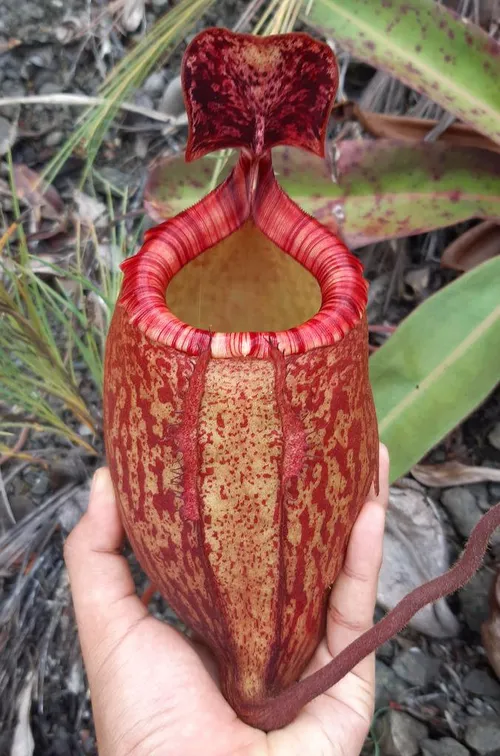 16. By Andrew Pranada
16. By Andrew Pranada 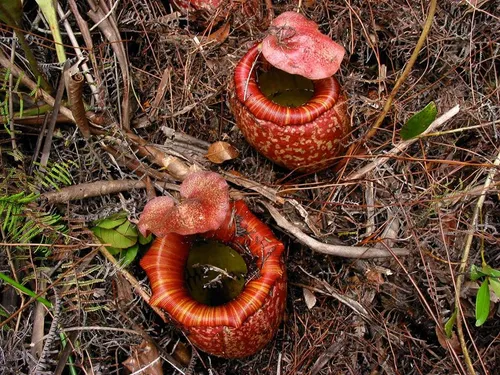 17. By Leonardo Co
17. By Leonardo Co 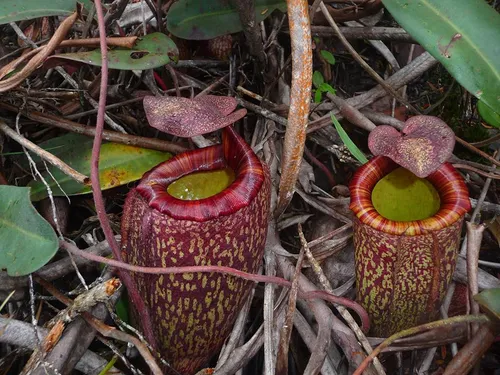 18. Unknown author, please contact me for credit
18. Unknown author, please contact me for credit 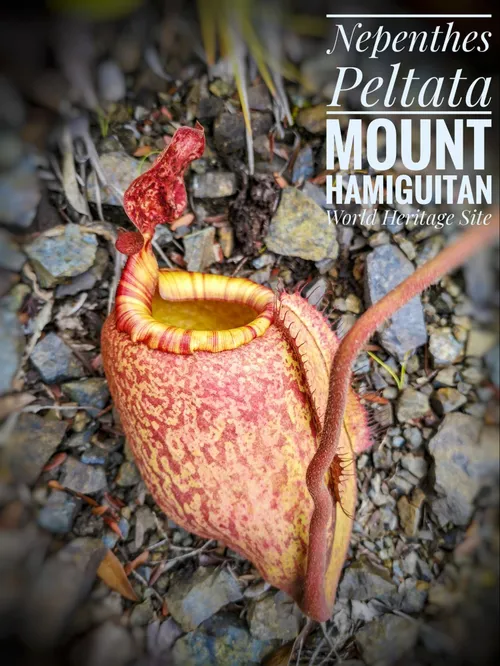 19. By Bunyien Huang
19. By Bunyien Huang 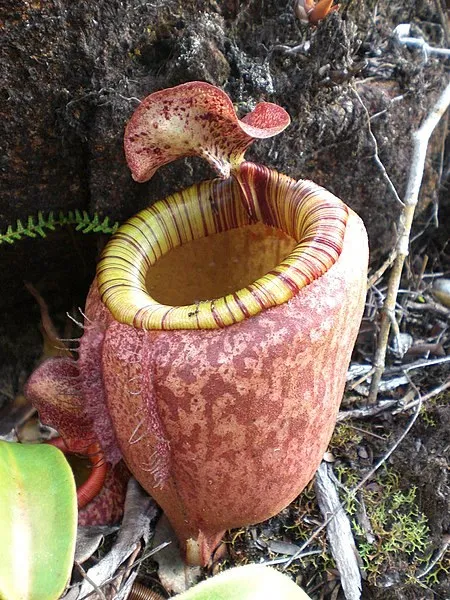 20. By Kleo Marlo Sialongo
20. By Kleo Marlo Sialongo 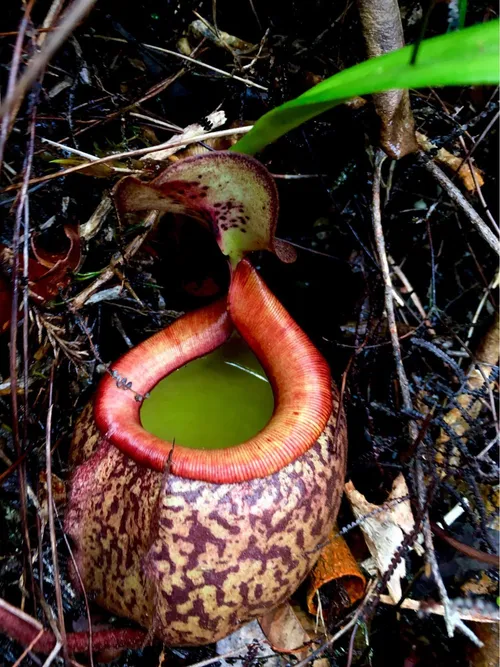 21. By Mel Bryan Escobido Solis
21. By Mel Bryan Escobido Solis Nearly all species of Nepenthes produce dimorphic pitchers: generally dark colored lower pitchers with fringed wings which are specialized to capture ground-dwelling prey, and generally lighter colored, gracile upper pitchers which are specialized to capture flying prey. However some species such as N. ampullaria, N. palawanensis, and N. rajah are exceptions, and only rarely produce upper pitchers. N. peltata also seems to be one of these species, with upper pitchers and vining growth apparently never or rarely observed. However, Mark Rouse has provided a photograph of what may be a rare upper pitcher:
Click on any photo to zoom in. Use arrow keys or swipe to navigate.
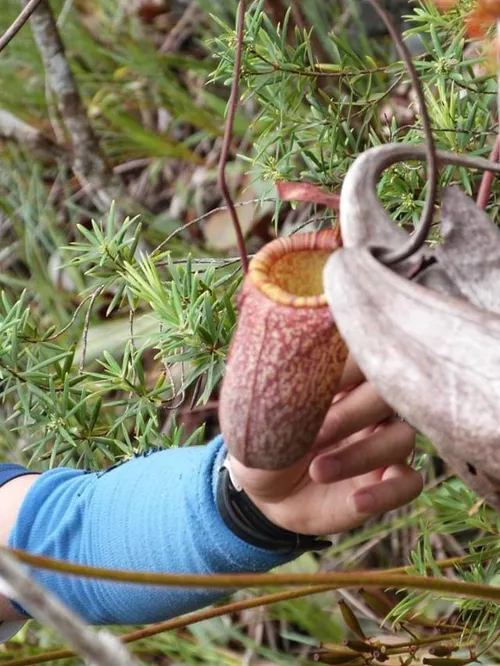 22. Possible upper pitcher in-situ. Note the reduced wings and possible rearward tendril attachment
22. Possible upper pitcher in-situ. Note the reduced wings and possible rearward tendril attachment Waxy zone
The wazy zone of N. peltata is highly variable in coloration. In my personal collection, there is a wide spectrum of forms, including totally colorless wazy zones, waxy zones with varying degrees of speckling, and waxy zones with a purple/red color gradient:
Click on any photo to zoom in. Use arrow keys or swipe to navigate.
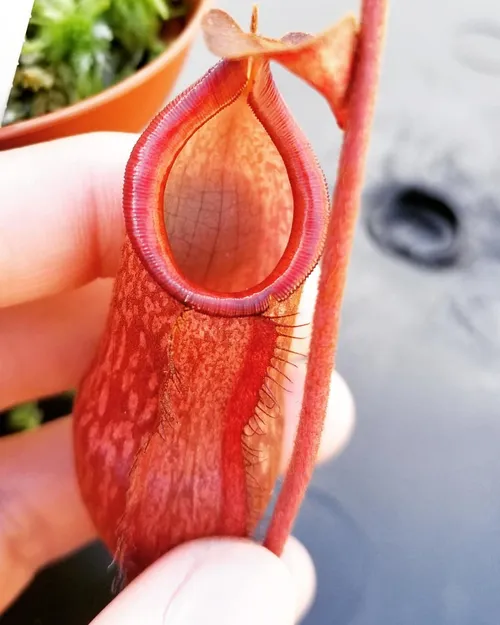 23. Various N. peltata clones from my personal collection showing a wide range of wazy zone coloration
23. Various N. peltata clones from my personal collection showing a wide range of wazy zone coloration 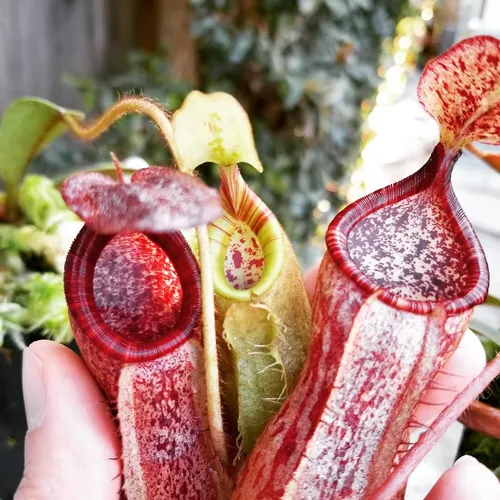 24. Various N. peltata clones from my personal collection showing a wide range of wazy zone coloration
24. Various N. peltata clones from my personal collection showing a wide range of wazy zone coloration 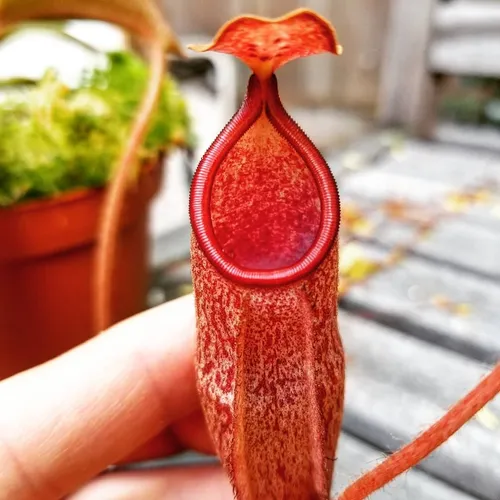 25. Various N. peltata clones from my personal collection showing a wide range of wazy zone coloration
25. Various N. peltata clones from my personal collection showing a wide range of wazy zone coloration Pitcher shape
N. peltata has a highly variable pitcher shape, ranging from ellipsoidal (think N. northiana), to urceolate (think N. ampullaria), to ovate (think N. sibuyanensis) - and interestingly, the pitcher shape of N. peltata has become a slight point of contention amongst hobbyists.
Many hobbyists have the impression that N. peltata must have very squat, almost globose pitchers, and that if a particular plant does not, then it must be a hybrid or introgressed. This is a view held even by some very experienced growers. Despite the pervasiveness of this view, I do not agree - I think the most parsimonious and reasonable stance to adopt is that the vast majority of N. peltata in cultivation have pitcher morphology that falls squarely within normal variation for the species. In particular, the N. peltata clones sold by Borneo Exotics and Andreas Wistuba fall under the most scrutiny for potentially being hybrids. I hypothesize that this is driven largely by wishful thinking - that is, that because the incredibly tubby pitchers that have been photographed in-situ are the most visually striking, growers want their N. peltata to look accordingly - and when this expectation is not met, they suspect that their plant is not “pure”.
On the other hand there are valid reasons for skepticism about N. peltata’s purity amongst hobbyists. There are indeed examples of sympatric Nepenthes species that hybridize so readily in-situ that it is notoriously difficult to collect pure seed of any individual species (e.g. the N. macfarlanei, N. ramispina, and N. sanguinea hybrid swarm on Gunung Ulu Kali). Likewise, N. peltata grows sympatrically with N. alata, N. micramphora, and N. justinae, and overlaps in altitudinal range with N. hamiguitanensis - and indeed, putative hybrids between N. peltata and some of these other species have been observed, suggesting that N. peltata is not reproductively isolated from its neighbors.
However, this alone is not a good enough reason to immediately suspect that a non-squat plant is a hybrid, especially when judging from pitcher morphology alone. I will elaborate below on why I believe this, and show pictures of N. peltata both in-situ and in cultivation that I hope will make the case that N. peltata is simply a highly variable species—and not one that is so promiscuous that hybrids are common in cultivation.
2. Available Clones
The Borneo Exotics and Wistuba clones
The most widely available clones of this species come from two distributors. Borneo Exotics (hereafter referred to as BE) sells a single clone under the catalog number BE-3464, and Andreas Wistuba (hereafter referred to as AW) sells several assorted clones that appear to be fairly similar. Both the BE and AW clones show strong red coloration on the underside of the lamina that is present on developing leaves and remains into maturity.
This red coloration is common in N. peltata, but not universal. In fact, most pictures of N. peltata in-situ do not show such coloration. In my personal collection, the proportion of clones showing red lamina undersides is roughly 50%. The other 50% either do not retain this coloration once the leaf has matured, or are simply completely green at all times. In strong light, the BE and AW clones will also flush red on the upper lamina surface. These clones are also petiolate, and have a pronounced indumentum of blonde to brown hairs that is most noticeable on the petioles and developing leaves. True to their name, the BE and AW clones also sport a peltate tendril insertion, with the insertion on the AW clones being more pronounced than on the BE clone—that is to say, the distance from leaf apex to tendril insertion is noticeably greater on the AW clones. The BE and AW clones also have very similar lid shapes - ovate at the base and strongly truncated, so as to be trapezoidal.
So far, all of these traits in aggregate make the BE and AW clones very typical and fairly uniform. It thus strikes me as unlikely that any of these clones could be hybrids, as one would expect that some of these traits would be reduced or intermediate between N. peltata and the other parent if this were the case.
The photos below show the similarity in vegetative parts between BE-3464 (left) and an AW clone (right) in my personal collection:
Click on any photo to zoom in. Use arrow keys or swipe to navigate.
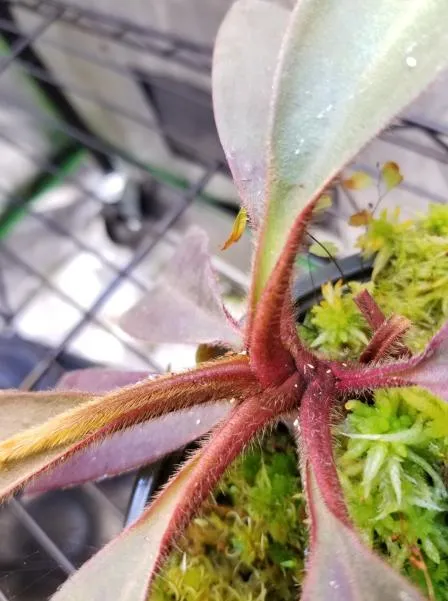 26. Indumentum and red coloration on petioles
26. Indumentum and red coloration on petioles 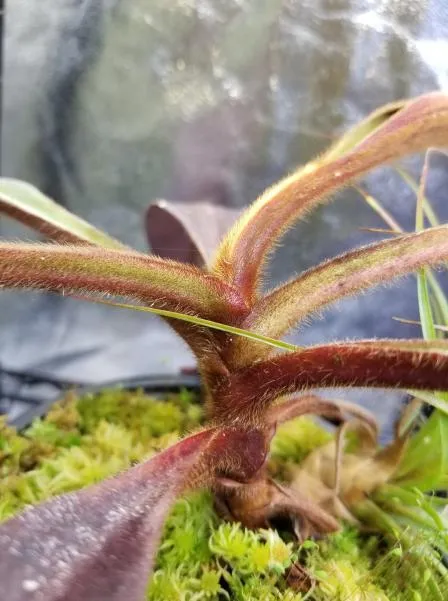 27. Indumentum and red coloration on petioles
27. Indumentum and red coloration on petioles 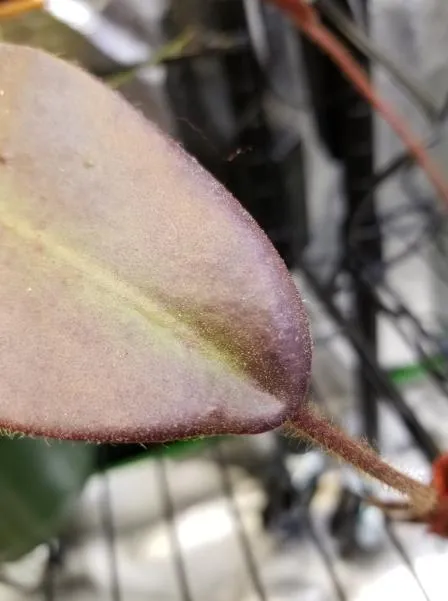 28. Tendril insertions
28. Tendril insertions 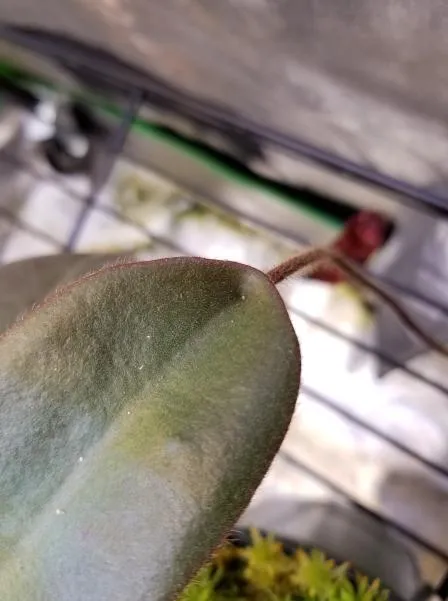 29. Tendril insertions
29. Tendril insertions 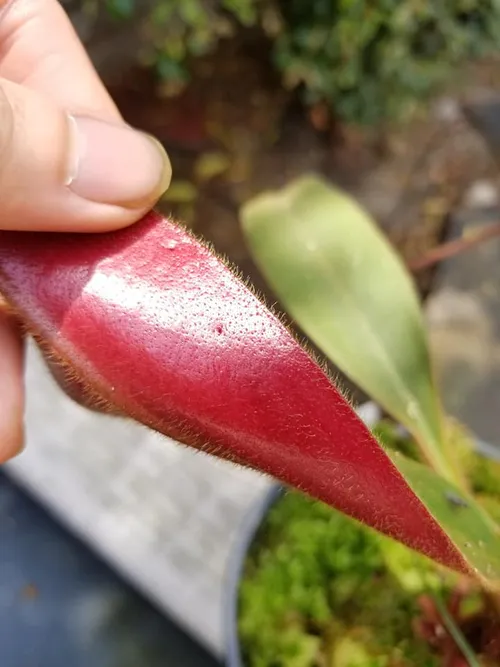 30. Red lamina undersides and indumenta
30. Red lamina undersides and indumenta 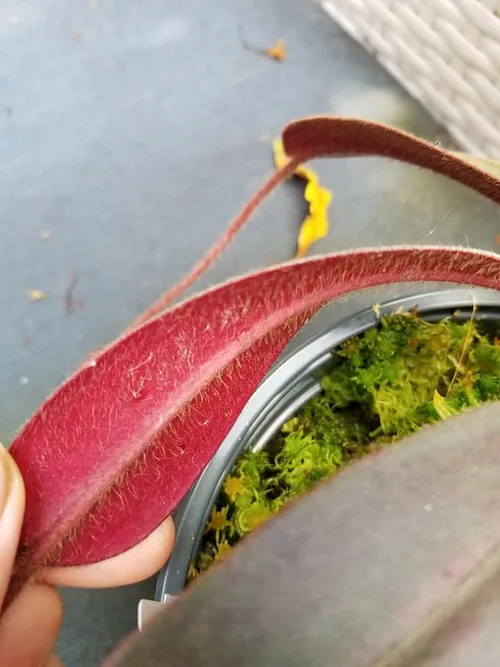 31. Red lamina undersides and indumenta
31. Red lamina undersides and indumenta 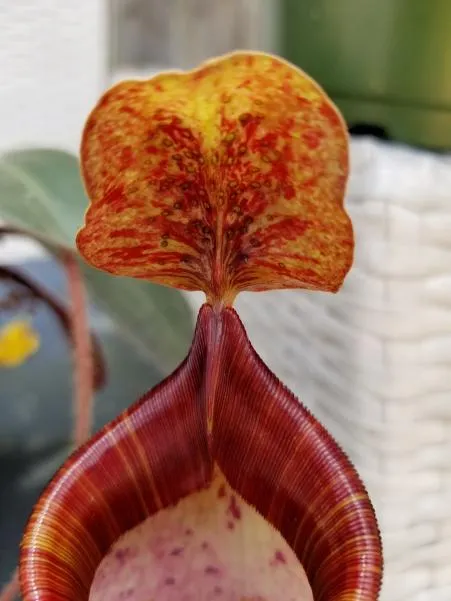 32. Lid detail showing ovate shape with truncated ends, gland distribution, and basal crests
32. Lid detail showing ovate shape with truncated ends, gland distribution, and basal crests 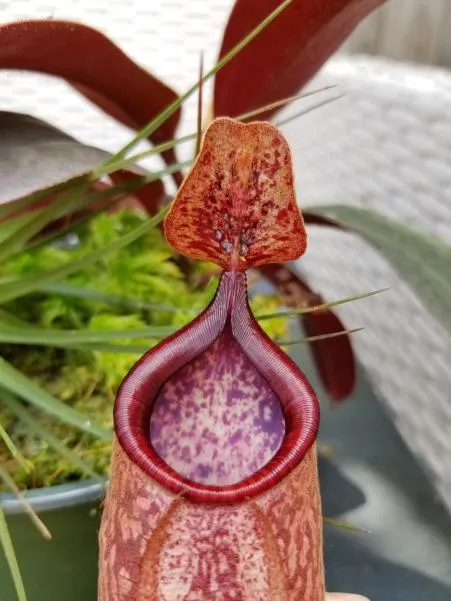 33. Lid detail showing ovate shape with truncated ends, gland distribution, and basal crests
33. Lid detail showing ovate shape with truncated ends, gland distribution, and basal crests Note the consistency between the two clones, and also note the remarkable similarity between these clones and wild N. peltata. This should not be the case if one or more of these clones were a hybrid.
But indeed, many if not most hobbyists assume that the BE clone is a hybrid due to the shape of its pitchers, which are not as tubby as people expect. The AW clones are sometimes also met with skepticism. I think that skepticism stems from two main reasons:
- People are drawing conclusions from immature pitchers and/or plants that are not grown to their fullest potential
- People are closed to the possibility that non-tubby pitcher shapes can fall within normal variation for the species
I find both of these reasons quite odd. Regarding reason #1, it is well known that some species such as N. veitchii change shape significantly as the plant matures. Young N. veitchii produce relatively tall and skinny pitchers with unimpressive peristomes; truly impressive, robust pitchers with flared peristomes are not really produced until N. veitchii is at least one to two feet across or more in my observation, yet no one directs such heightened skepticism about purity toward N. veitchii. It is simply understood that this species has wide variation in morphology throughout the course of its life - a phenomenon known ontogenetic variability. The same could be said of N. mirabilis var. globosa, which also tends not to produce its impressive, characteristically globose pitchers until maturity.
In my opinion, N. peltata probably shares a similar trajectory of ontogenetic variability, thus when people judge the pitcher morphology of a six-inch cultivated plant, they are judging it prematurely.
Click on any photo to zoom in. Use arrow keys or swipe to navigate.
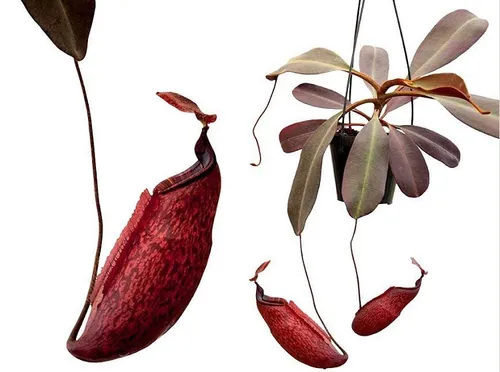 34. Borneo Exotics stock photo of BE-3464 showing immature looking, skinny pitchers even on a relatively large plant
34. Borneo Exotics stock photo of BE-3464 showing immature looking, skinny pitchers even on a relatively large plant 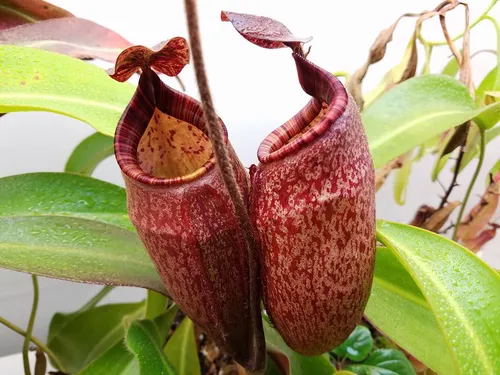 35. A well-grown BE-3464 N. peltata showing tubby pitchers, expertly grown and photographed by Michael Kevin Smith
35. A well-grown BE-3464 N. peltata showing tubby pitchers, expertly grown and photographed by Michael Kevin Smith 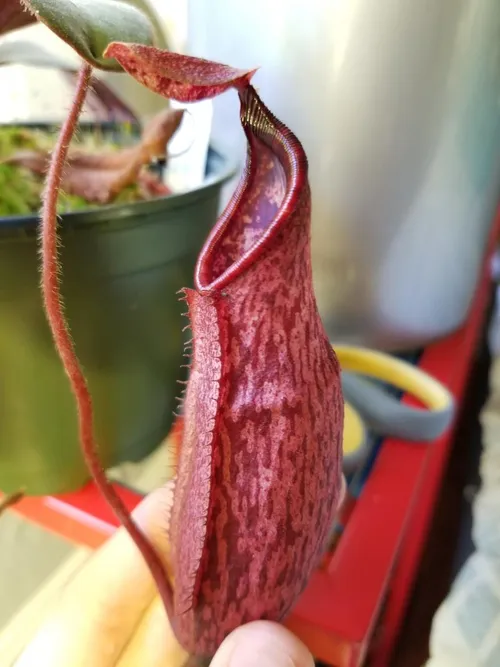 36. AW clone of N. peltata from my collection, showing skinny immature pitchers. This plant was just over six inches in diameter
36. AW clone of N. peltata from my collection, showing skinny immature pitchers. This plant was just over six inches in diameter 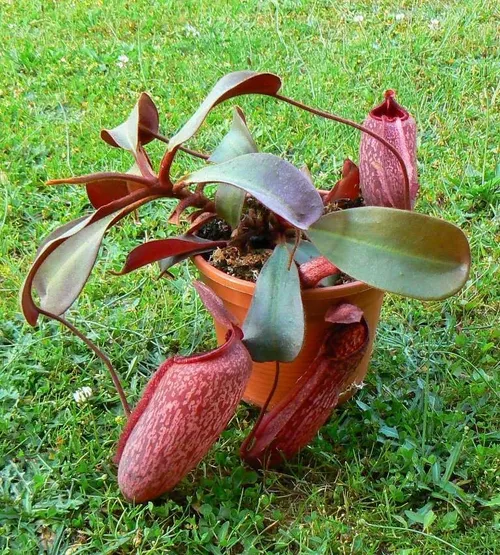 37. A beautiful seed-grown specimen grown by Carsten Schulz that strongly resembles the AW and BE clones. Note the difference in pitcher shape between the immature basal and the top growth
37. A beautiful seed-grown specimen grown by Carsten Schulz that strongly resembles the AW and BE clones. Note the difference in pitcher shape between the immature basal and the top growth 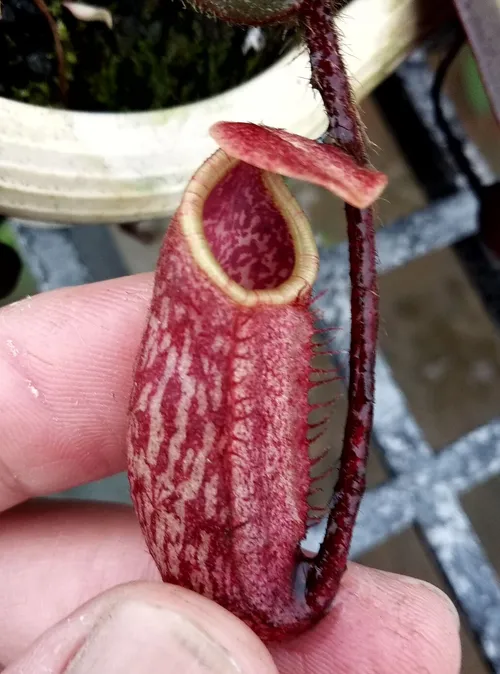 38. An immature pitcher from a rooted basal on a seed grown N. peltata, courtesy of Jack Chiang
38. An immature pitcher from a rooted basal on a seed grown N. peltata, courtesy of Jack Chiang 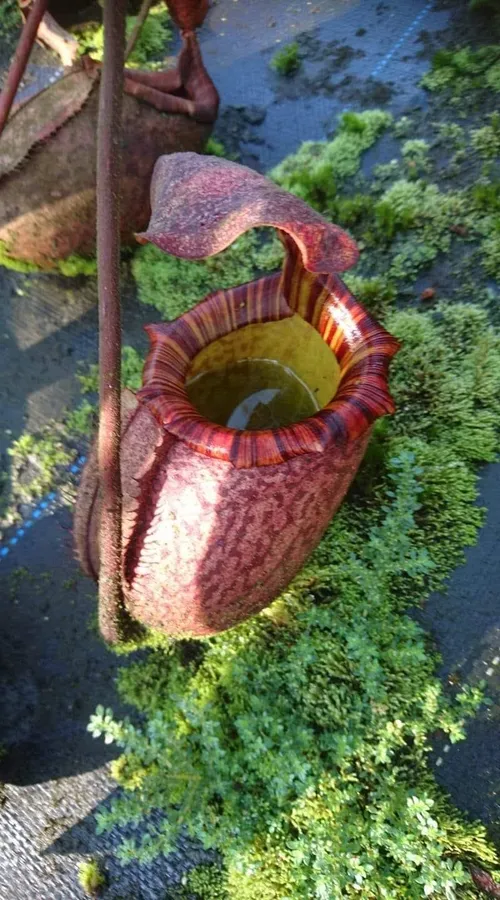 39. A mature pitcher on the same plant, courtesy of Jack Chiang
39. A mature pitcher on the same plant, courtesy of Jack Chiang Regarding reason #2, again, it is best to look at other variable species to provide context. Throughout its range, N. maxima can be tall or squat, colorful or plain, and have a flared or narrow peristome, and everything in between. N. truncata can be tall or squat, green, dusky or red, and have varying degrees of peristome striping. N. mollis can have extremely tall necks, stouter necks, overall dark coloration or light coloration, and can have a speckled pitcher body, or an all-green or all-red one - and no one bats an eye. Unless there were particularly strong stabilizing selection on pitcher morphology (e.g. the mouth proportions of N. lowii upper pitchers or N. rajah pitchers), it is to be expected these species would present a wide array of forms. The hobbyist community should be similarly open-minded about N. peltata.
These are all N. maxima… (photos courtesy of Alfindra Primaldhi)
Click on any photo to zoom in. Use arrow keys or swipe to navigate.
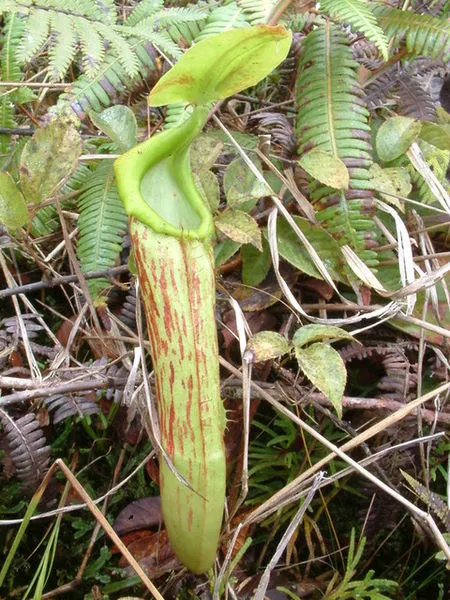 40. N. maxima
40. N. maxima 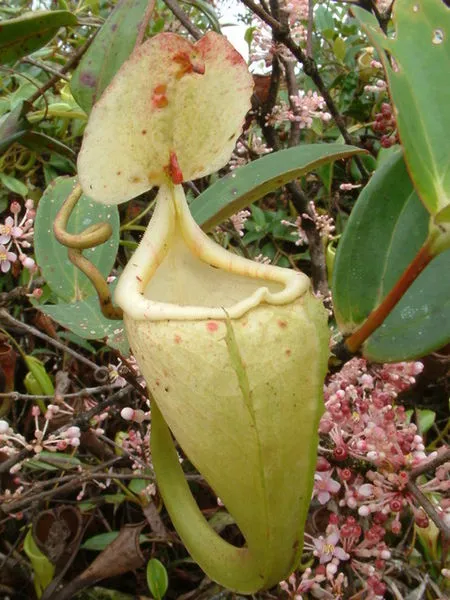 41. N. maxima
41. N. maxima 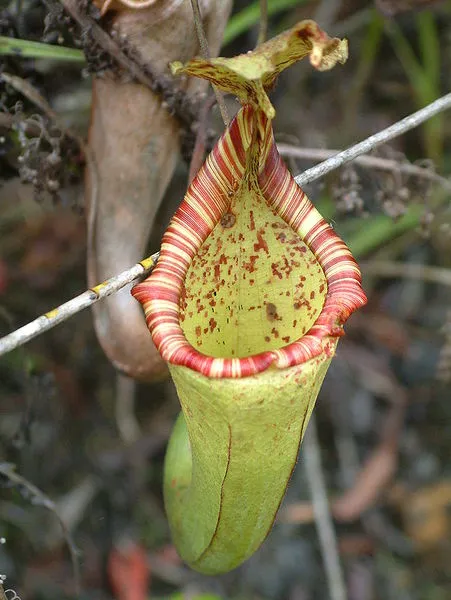 42. N. maxima
42. N. maxima These are all N. mollis… (photos courtesy of Jeremiah Harris, Chien Lee and Matze)
Click on any photo to zoom in. Use arrow keys or swipe to navigate.
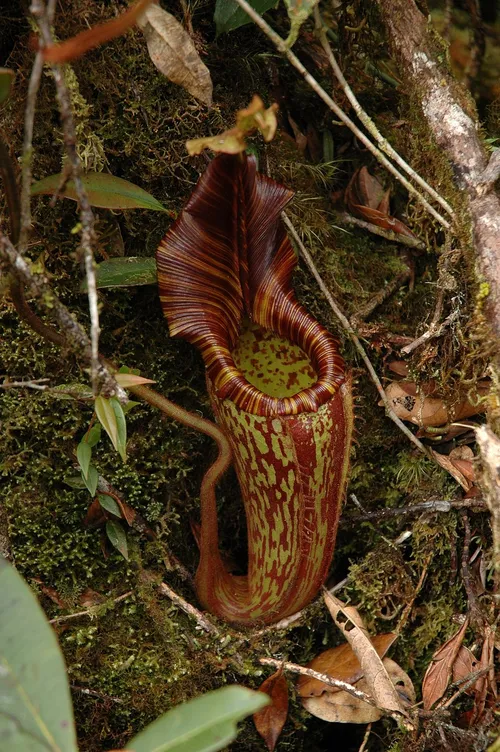 43. N. mollis, by Jeremiah Harris
43. N. mollis, by Jeremiah Harris _%20by%20Chien%20Lee.CsUbTdIB_2fEfyd.webp) 44. N. mollis (N. sp. Bagong), by Chien Lee
44. N. mollis (N. sp. Bagong), by Chien Lee .Dc9bp4ds_ZMUo2D.webp) 45. N. mollis, by Matze (green.jaws)
45. N. mollis, by Matze (green.jaws) And these are all N. peltata… except for the BE-3464 at the end, which is somehow a hybrid? Photos courtesy of Jeromel Villame, Stewart McPherson, Kleo Marlo Sialongo, Mark Rouse, and Michael Kevin Smith.
Click on any photo to zoom in. Use arrow keys or swipe to navigate.
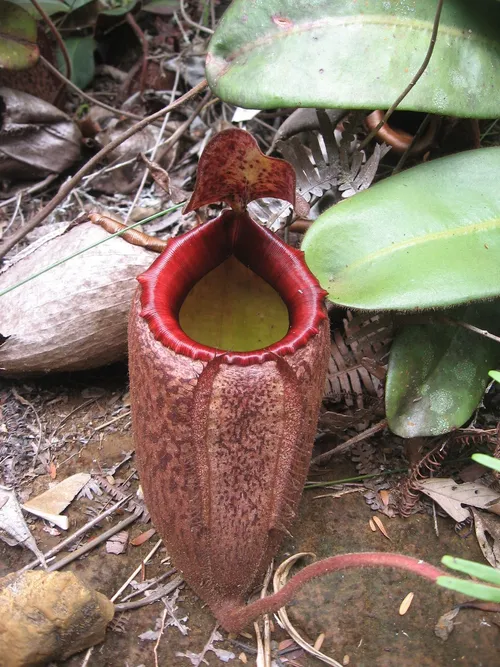 46. N. peltata, by Jeromel Villame
46. N. peltata, by Jeromel Villame 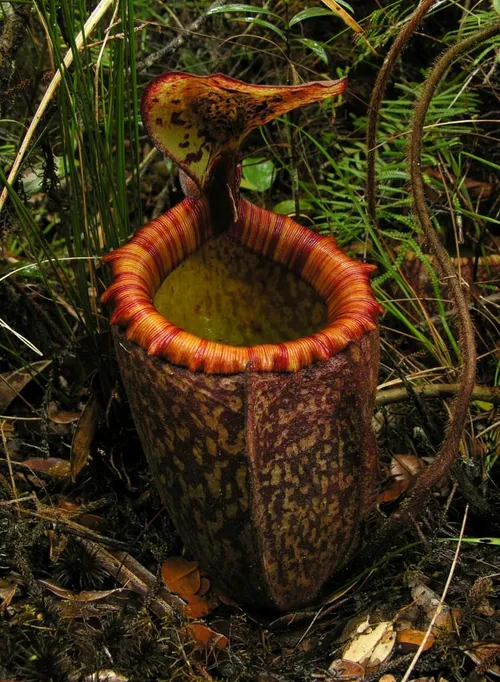 47. N. peltata, by Stewart McPherson
47. N. peltata, by Stewart McPherson 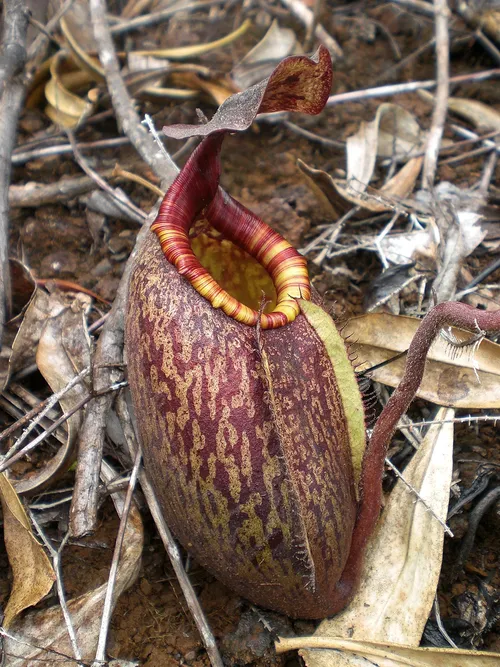 48. N. peltata, by Kleo Marlo Sialongo
48. N. peltata, by Kleo Marlo Sialongo 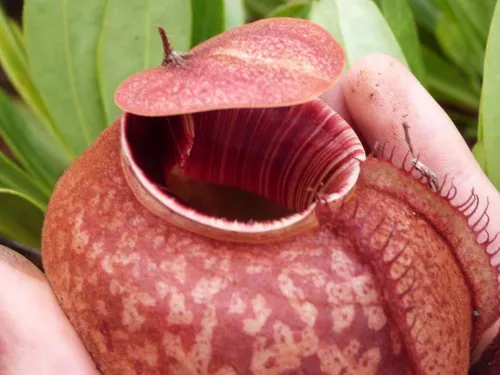 49. N. peltata, by Mark Rouse
49. N. peltata, by Mark Rouse 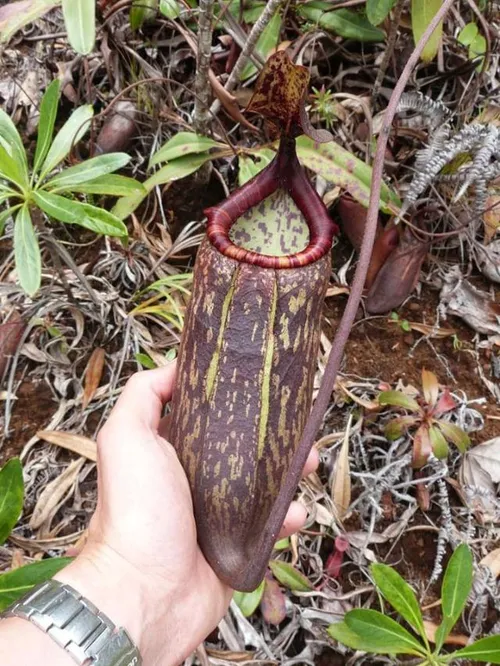 50. N. peltata, by Mark Rouse
50. N. peltata, by Mark Rouse 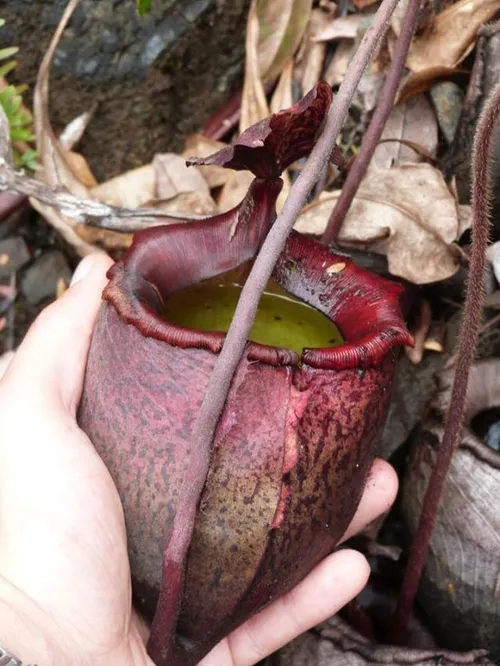 51. N. peltata, by Mark Rouse
51. N. peltata, by Mark Rouse 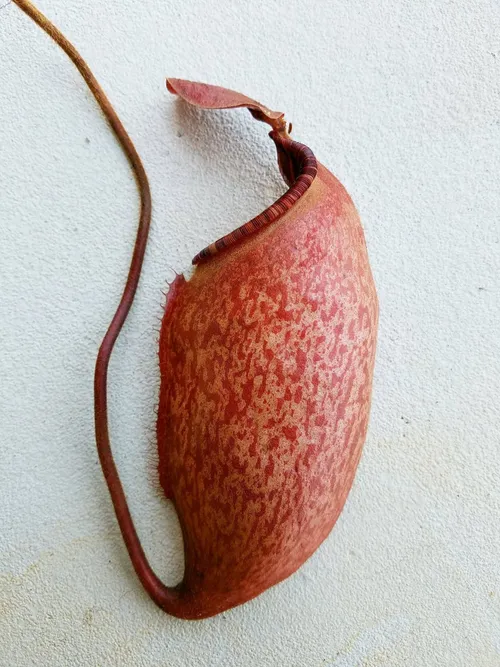 52. N. peltata, BE-3464, by Michael Kevin Smith
52. N. peltata, BE-3464, by Michael Kevin Smith I hope I have made a convincing case regarding the variability of N. peltata and shed light on morphological details that have not previously been discussed. If any hobbyists or botanists that have been to Mt. Hamiguitan could weigh in, I would love to hear it!
Red Phantom and Yellow Phantom
The two most highly coveted forms of N. peltata in cultivation, bar none, are ‘Red Phantom’ and ‘Yellow Phantom’, grown by Shinya Yamada in Japan. Wild collected shortly around the time the species was described, these cultivars are both stunning forms that capture some of the variability of the species. ‘Red Phantom’ has red leaf undersides and a weakly crenellated red peristome with understated stripes. ‘Yellow Phantom’ has completely green leaves, a strongly crenellated and boldly striped peristome, an overall yellowish color, and an exaggerated, almost globose pitcher shape.
Click on any photo to zoom in. Use arrow keys or swipe to navigate.
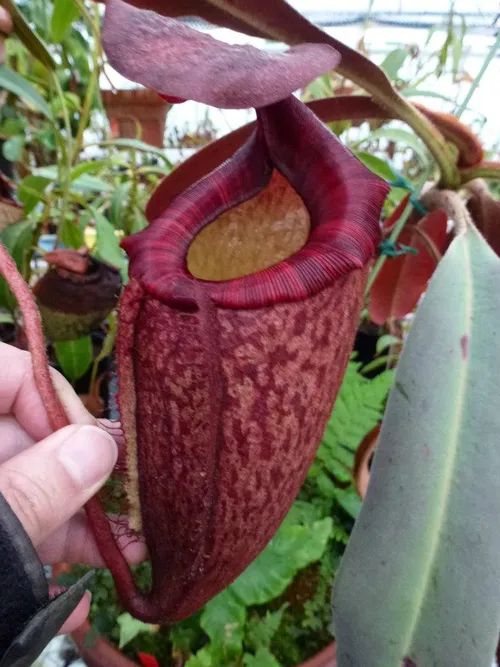 53. N. peltata Red Phantom, by Shinya Yamada
53. N. peltata Red Phantom, by Shinya Yamada 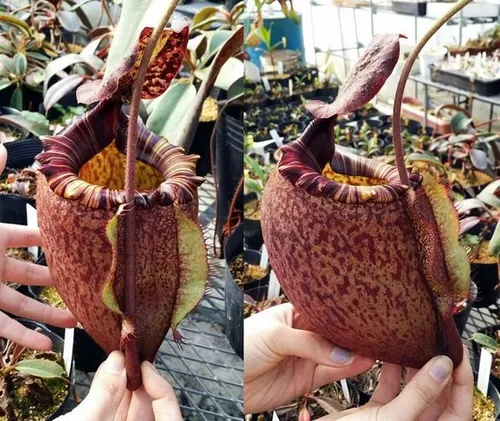 54. N. peltata Yellow Phantom, by Shinya Yamada
54. N. peltata Yellow Phantom, by Shinya Yamada Native Exotics
Native Exotics maintains at least one clone in tissue culture. At one point, several lines were started in their lab from seed provided by Jeremiah Harris, but they are assorted and it is currently unknown how many unique clones there are. I have several plants from Native Exotics material in my personal collection, and they are all very similar to each other. These clones may or may not have reddish coloration on the undersides of developing leaves, pronounced indumenta, reddish speckling on the pitchers, striped peristomes, ovate/truncate lids, moderately pronounced peristome ridges, heavily speckled wazy zones, and of course, peltate leaves on larger happy plants.
A couple of Native Exotics plants from my personal collection.
Click on any photo to zoom in. Use arrow keys or swipe to navigate.
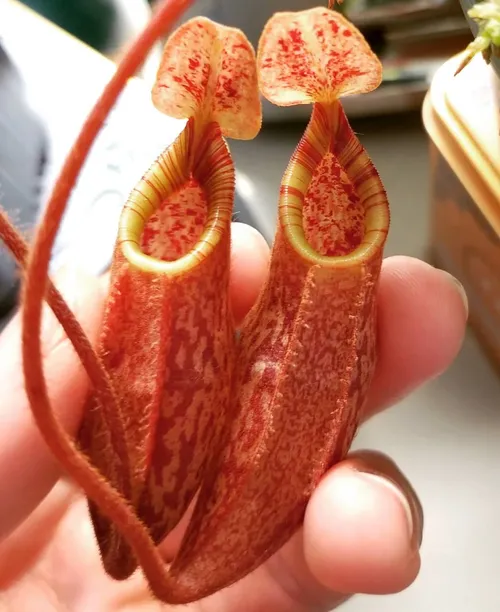 55. N. peltata NE
55. N. peltata NE 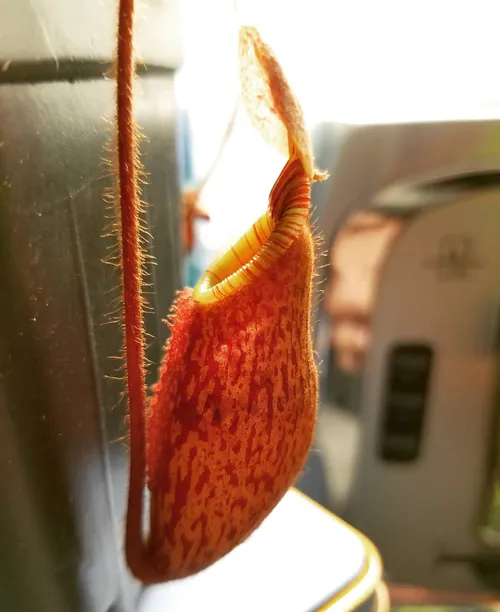 56. N. peltata NE
56. N. peltata NE 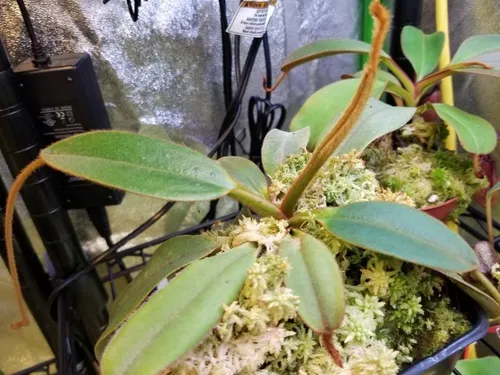 57. N. peltata NE
57. N. peltata NE  58. N. peltata NE
58. N. peltata NE 3. Cultivation
Temperature and humidity
N. peltata has a wide altitudinal distribution of 865 to 1635 meters above sea level. This wide distribution paired with the relatively low lower bound of 865m, has prompted some growers such as Michael Kevin Smith to experiment with growing N. peltata as a warm intermediate/borderline lowlander with no nighttime temperature drops, with great results. Native Exotics followed suit with positive results, and I have been growing this species without nighttime temperature drops below 70F for the past two years.
At the other extreme, I have also grown this species in ultra-highland conditions, which I find does not kill the plant, but causes a near cessation of growth. Overall, this species is not picky about temperatures, but like with most species that have a wide temperature tolerance, one can achieve faster growth by growing N. peltata on the warmer side. In short, if you can only provide highland conditions, you should be able to grow this species. If you can only provide lowland conditions, you should be able to grow this species. If you can provide either, then grow this species as lowlander and reap the benefits of accelerated growth.
Unlike hardier species such as N. maxima, I do not find this species to be a good candidate for windowsill growing. In ambient humidity, vegetative growth proceeds with no problem, with dramatic increases in leaf size (“leaf jumps”) even occurring in response to root fertilization, but pitchers will not be produced. If they are produced, they are very small and senesce early—not very rewarding. It is best to grow this species in at least 75-80% relative humidity.
Media
In-situ, N. peltata seems able to grow on a variety of substrates:
Click on any photo to zoom in. Use arrow keys or swipe to navigate.
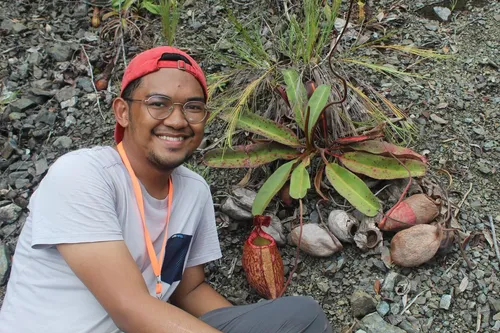 59. By Andrew Pranada
59. By Andrew Pranada  60. By Roy Ponce
60. By Roy Ponce 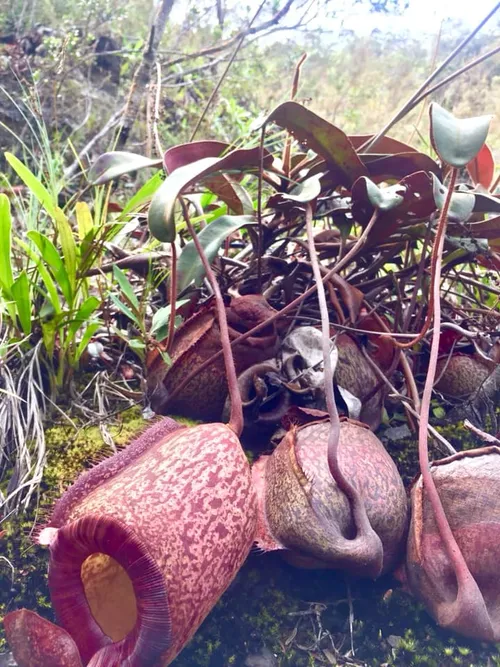 61. By Jef Mancera and the Plant and lichen discovery project
61. By Jef Mancera and the Plant and lichen discovery project 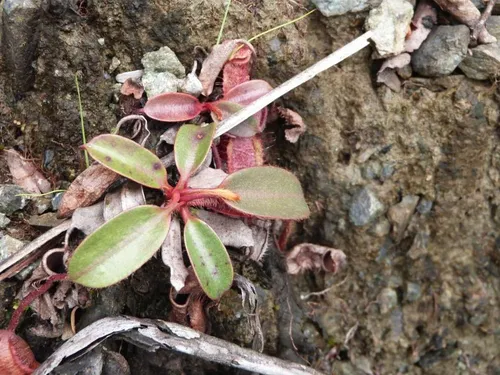 62. By Joeseph Sellado Quisado
62. By Joeseph Sellado Quisado  63. By Leonardo Co
63. By Leonardo Co 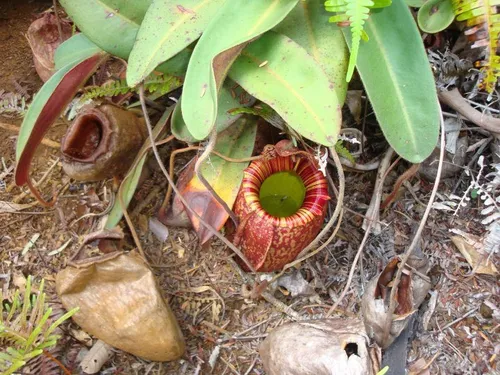 64. By Amari Francine Marty
64. By Amari Francine Marty 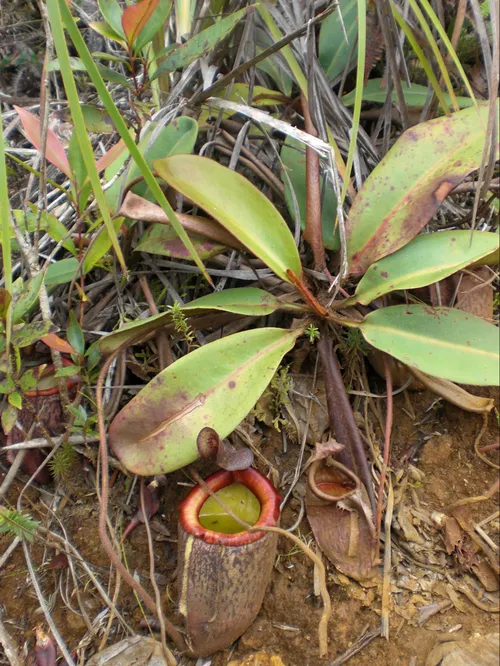 65. By Kleo Marlo Sialongo
65. By Kleo Marlo Sialongo 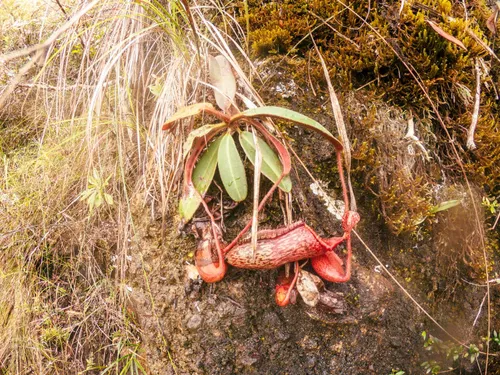 66. By Edward Jefrey Acera Dacalos
66. By Edward Jefrey Acera Dacalos These photos show N. peltata growing primarily in rocky or laterite soil, with leaf litter content ranging from heavy to totally absent. Seedlings seem able to establish themselves in relatively bare soil. Epiphytic N. peltata are probably rare and the species likely prefers to grow terrestrially.
Photos courtesy of Andrew Pranada, Roy Ponce; Jef Mancera and the Plant and lichen discovery in the southern Philippines project, NSF DEB-1754697 and DEB-1754667; Joeseph Sellado Quisado, Leonardo Co, Amari Francine Marty, Kleo Marlo Sialongo, Edward Jefrey Acera Dacalos, Aldwin G. Alinsub, Long Henson, and Da Bid (Ed: not yet added these to individual images above)
In cultivation, this makes N. peltata not very picky about growing media. In my personal collection, I have grown N. peltata in 100% long-fibered sphagnum moss, as well as 2:1 chunky perlite and long-fibered sphagnum moss, though I have lately settled on a 1:1 mix. Other growers use 100% akadama, which based on in-situ photographs is likely a great media choice, but expensive. For the vast majority of growers who are interested in growing N. peltata but do not care to optimize their soil mix for an ultramafic species, the 1:1 mix of perlite and long-fibered sphagnum moss will work well.
Light levels
N. peltata is observed to tolerate shady conditions, but grows best in direct sunlight. In my personal collection, I have found this species to grow best under a single layer of 50% aluminet, or around 18 inches under a 300W equivalent LED panel. I find that this light level promotes pitchering, and that lower light levels will support good vegetative growth but will cause intermittent or rare pitchering.
4. Hybrids
Natural hybrids
N. peltata is sympatric with three species—N. hamiguitanensis, N. justinae, and N. micramphora. For context, here are some photos of those respective species:
Click on any photo to zoom in. Use arrow keys or swipe to navigate.
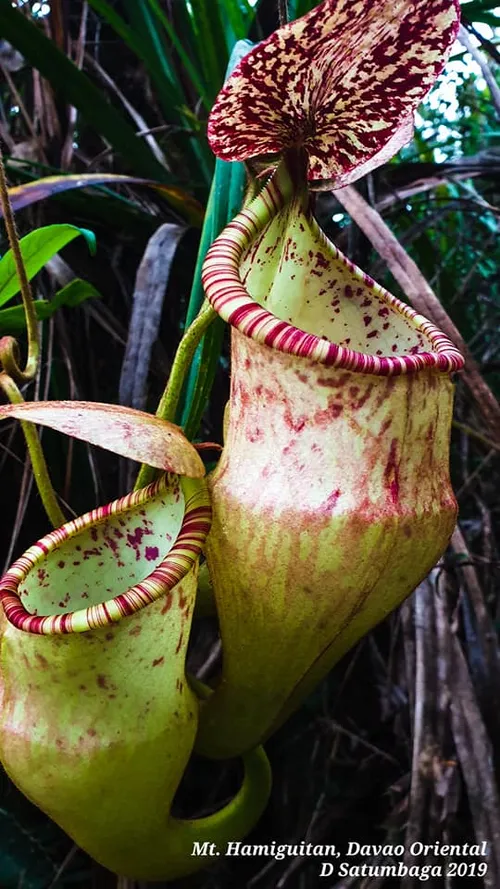 67. Nepenthes hamiguitanensis, by Dawn Satumbaga
67. Nepenthes hamiguitanensis, by Dawn Satumbaga 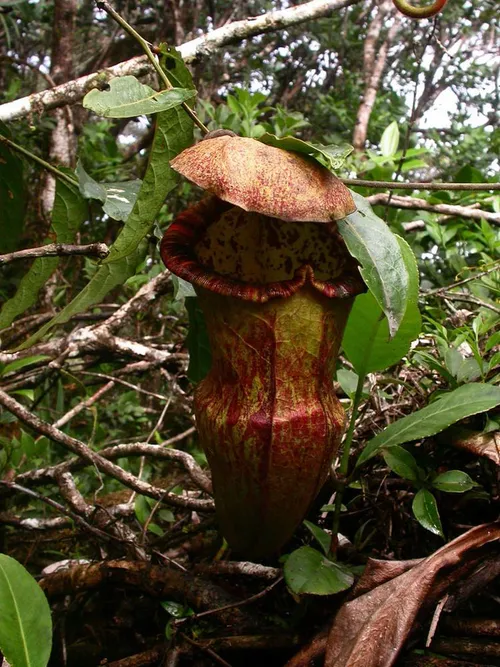 68. Nepenthes hamiguitanensis, by Pelser, P.B., J.F. Barcelona & D.L. Nickrent
68. Nepenthes hamiguitanensis, by Pelser, P.B., J.F. Barcelona & D.L. Nickrent 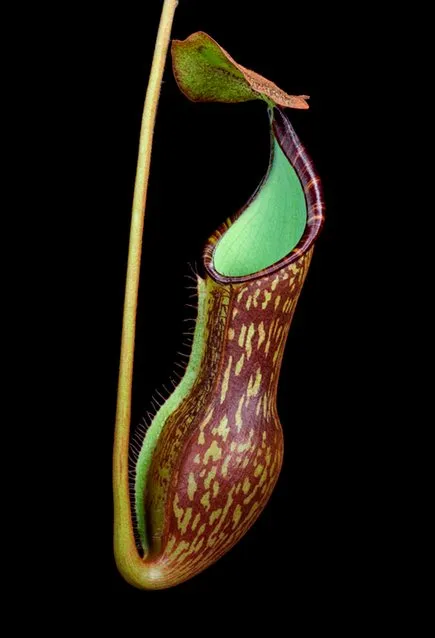 69. Nepenthes justinae, by Thomas Gronemeyer et al
69. Nepenthes justinae, by Thomas Gronemeyer et al 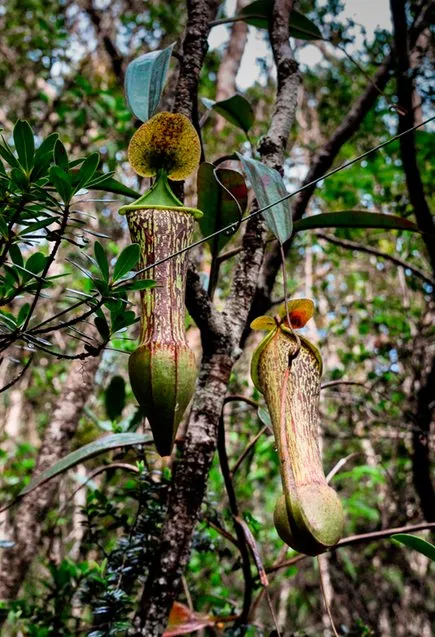 70. Nepenthes justinae, by Thomas Gronemeyer et al
70. Nepenthes justinae, by Thomas Gronemeyer et al 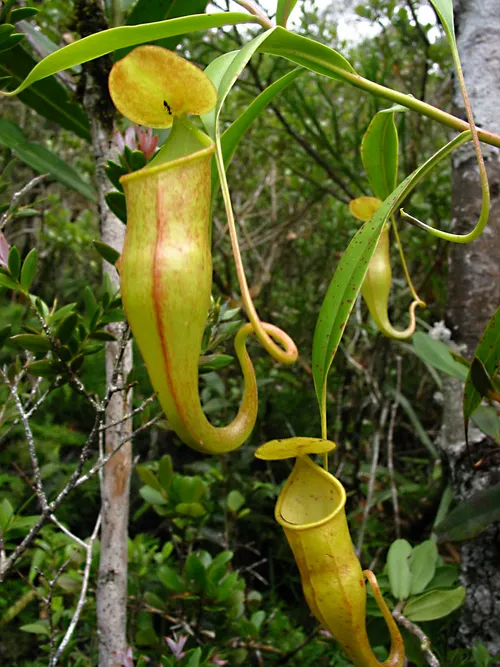 71. Nepenthes micramphora, by La cour des orchidées
71. Nepenthes micramphora, by La cour des orchidées 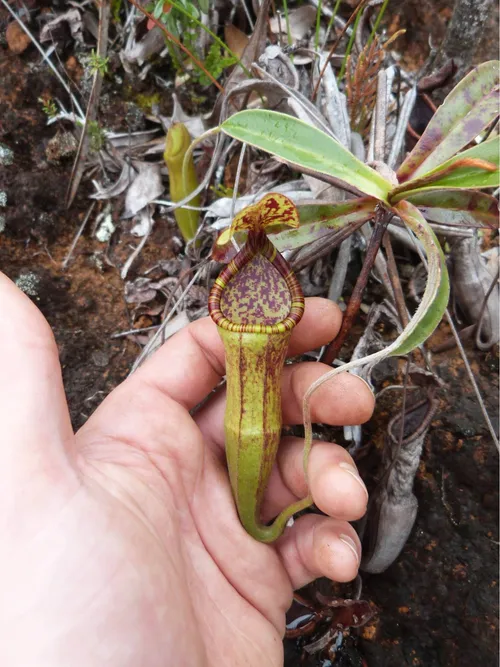 72. Nepenthes micramphora, by Mark Rouse
72. Nepenthes micramphora, by Mark Rouse In-situ, putative hybrids of N. peltata and N. justinae and N. hamiguitanensis can be readily observed, especially above 1400m.
Click on any photo to zoom in. Use arrow keys or swipe to navigate.
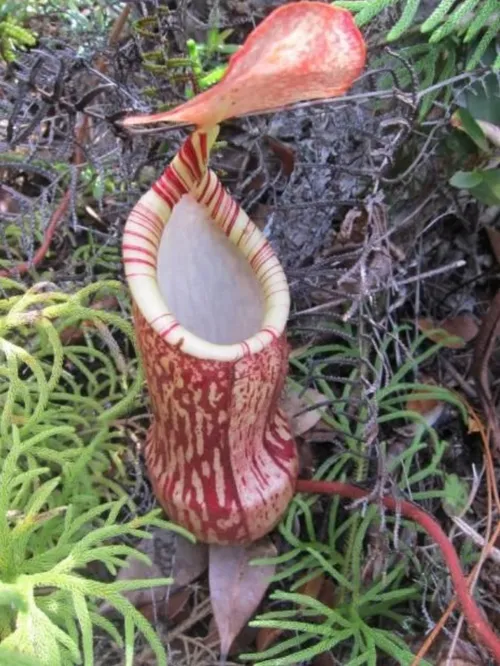 73. Putative hybrid involving N. peltata, by Victor B. Amoroso et al
73. Putative hybrid involving N. peltata, by Victor B. Amoroso et al 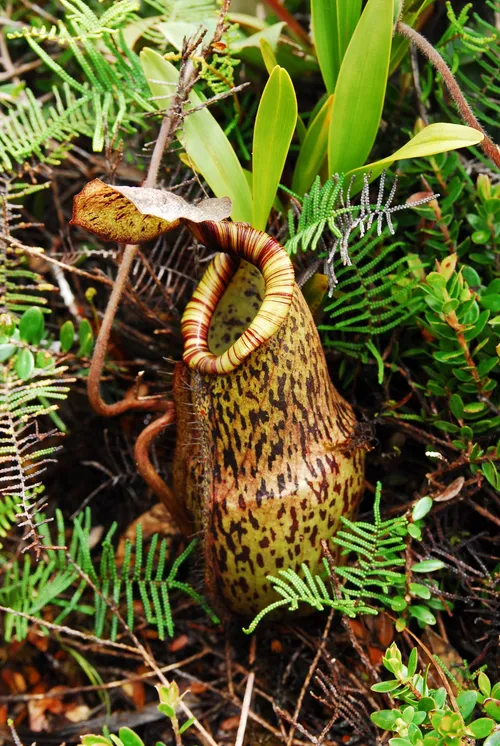 74. Putative hybrid involving N. peltata, by Thomas Gronemeyer
74. Putative hybrid involving N. peltata, by Thomas Gronemeyer 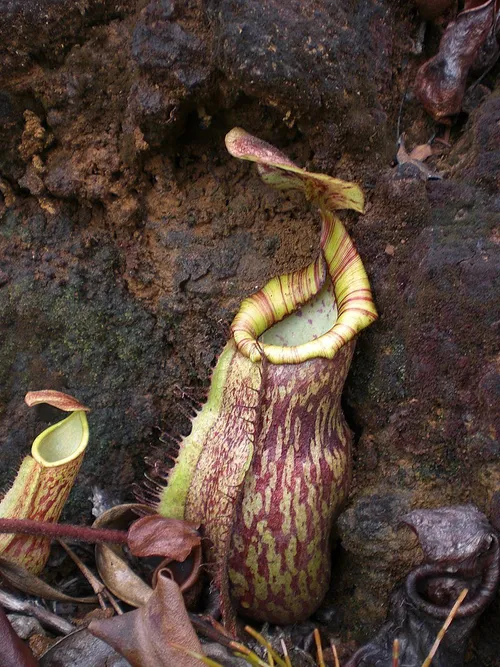 75. Putative hybrid involving N. peltata, by Kleo Marlo Sialongo
75. Putative hybrid involving N. peltata, by Kleo Marlo Sialongo 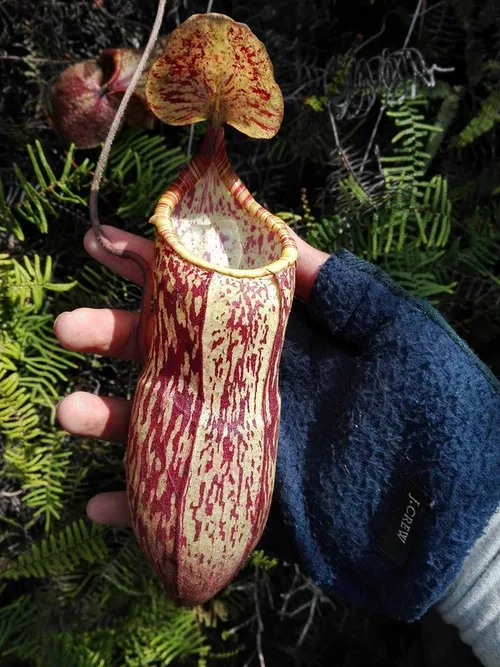 76. Putative hybrid involving N. peltata, by Rey Bonnin Gonzaga Naparan
76. Putative hybrid involving N. peltata, by Rey Bonnin Gonzaga Naparan Natural hybrids from wild-collected N. peltata seed have also popped up in cultivation. This plant - grown and photographed by Matt Richardson - has an odd mix of traits from both parents:
Click on any photo to zoom in. Use arrow keys or swipe to navigate.
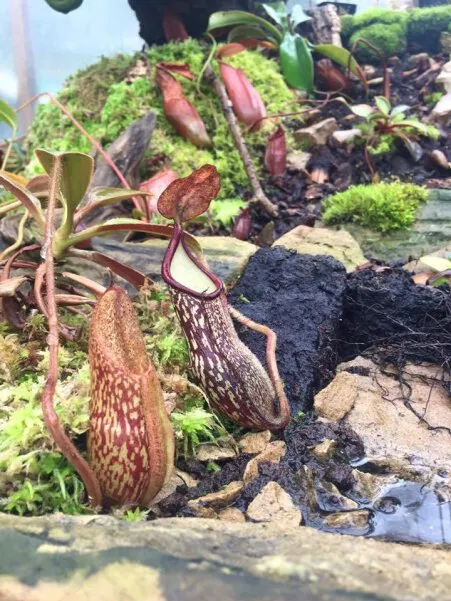 77. A natural hybrid from wild-collected N. peltata seed, likely with a N. justinae pollen parent, by Matt Richardson
77. A natural hybrid from wild-collected N. peltata seed, likely with a N. justinae pollen parent, by Matt Richardson 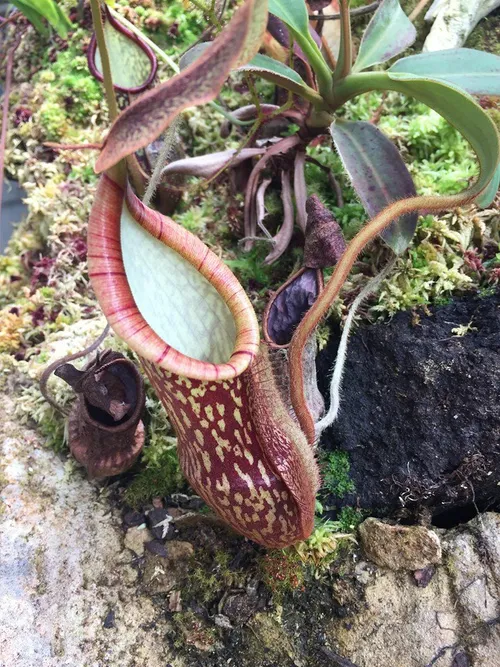 78. A natural hybrid from wild-collected N. peltata seed, likely with a N. justinae pollen parent, by Matt Richardson
78. A natural hybrid from wild-collected N. peltata seed, likely with a N. justinae pollen parent, by Matt Richardson 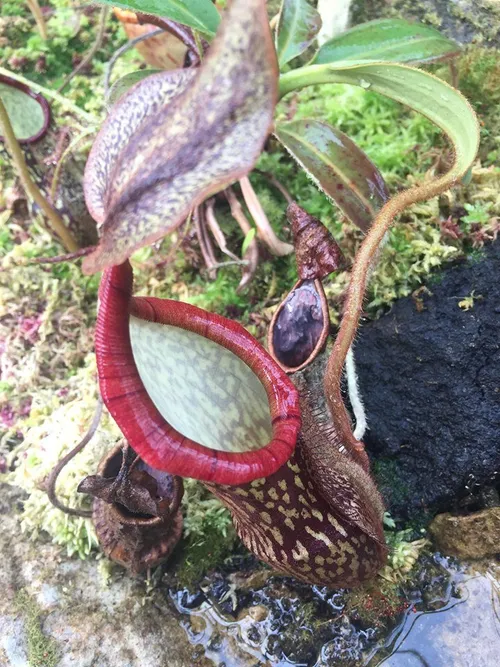 79. A natural hybrid from wild-collected N. peltata seed, likely with a N. justinae pollen parent, by Matt Richardson
79. A natural hybrid from wild-collected N. peltata seed, likely with a N. justinae pollen parent, by Matt Richardson 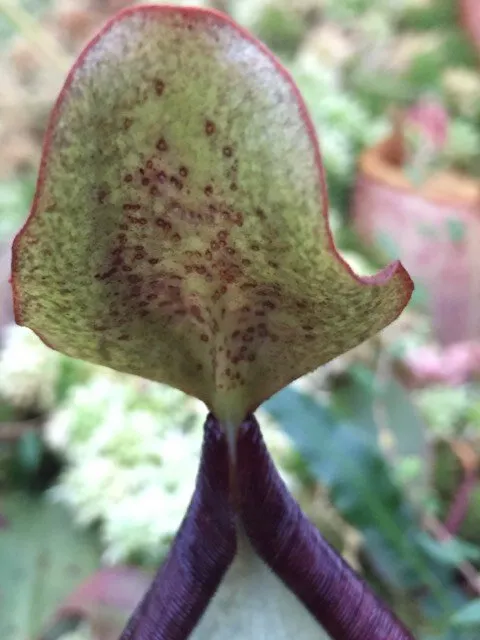 80. A natural hybrid from wild-collected N. peltata seed, likely with a N. justinae pollen parent, by Matt Richardson
80. A natural hybrid from wild-collected N. peltata seed, likely with a N. justinae pollen parent, by Matt Richardson 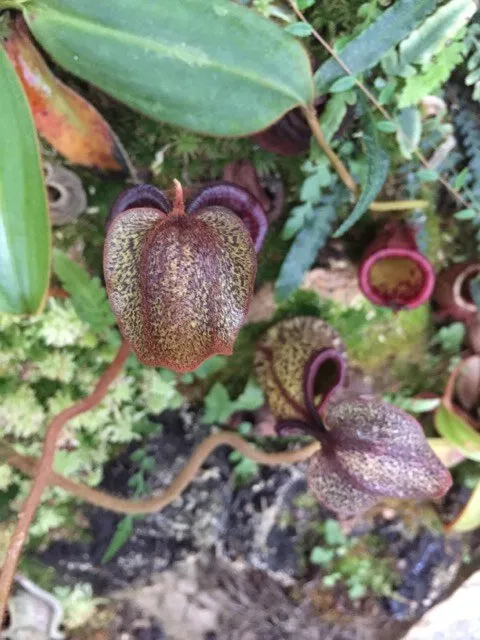 81. A natural hybrid from wild-collected N. peltata seed, likely with a N. justinae pollen parent, by Matt Richardson
81. A natural hybrid from wild-collected N. peltata seed, likely with a N. justinae pollen parent, by Matt Richardson 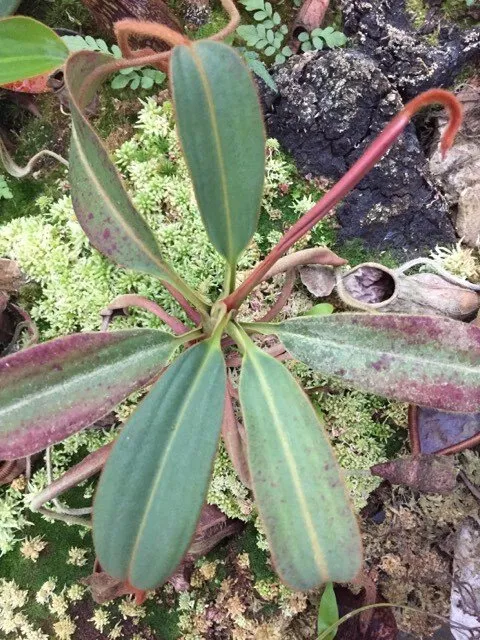 82. A natural hybrid from wild-collected N. peltata seed, likely with a N. justinae pollen parent, by Matt Richardson
82. A natural hybrid from wild-collected N. peltata seed, likely with a N. justinae pollen parent, by Matt Richardson N. justinae has made a very strong contribution to the pitcher shape, color and wazy zone, and its influence is also apparent in the reduced/absent indumentum on developing leaves and reduced nectar glands under the lid. The N. peltata influence is apparent in the red lamina undersides and pronounced indumentum on the tendrils.
More cultivated natural hybrids:
Click on any photo to zoom in. Use arrow keys or swipe to navigate.
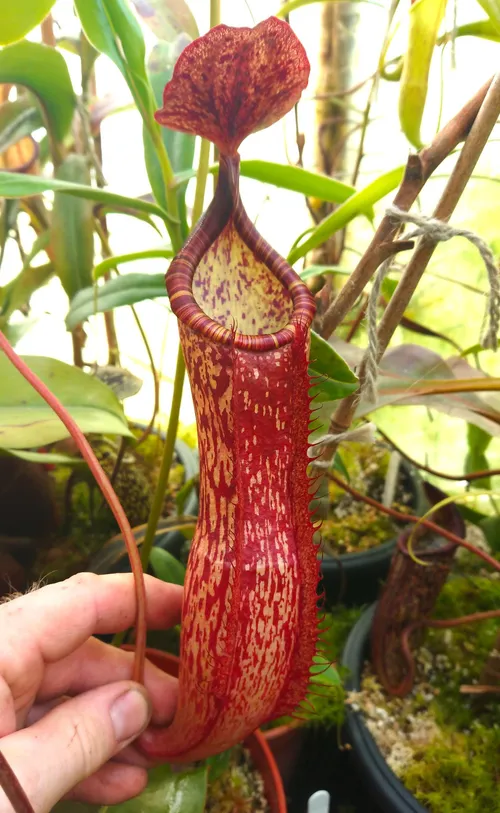 83. Cultivated natural hybrid from N. peltata seed, by Gareth Davies
83. Cultivated natural hybrid from N. peltata seed, by Gareth Davies 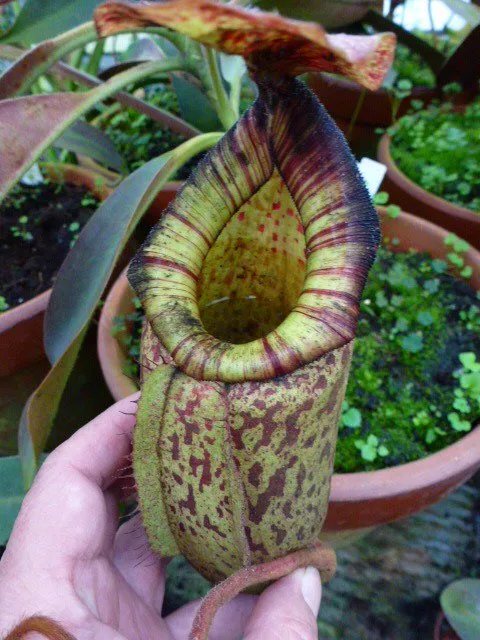 84. Cultivated natural hybrid from N. peltata seed, by Shinya Yamada
84. Cultivated natural hybrid from N. peltata seed, by Shinya Yamada 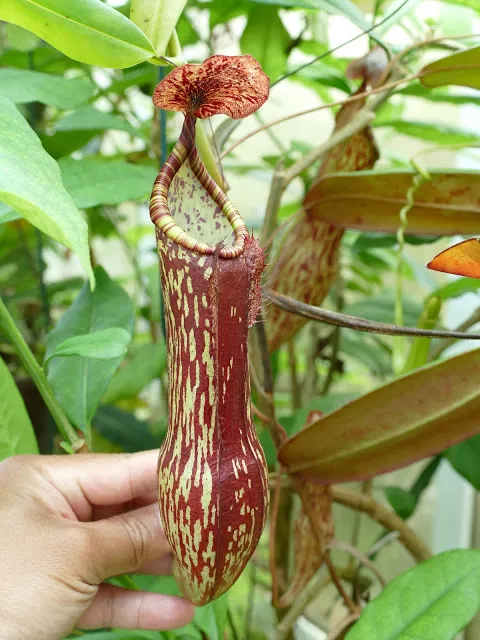 85. Cultivated natural hybrid from N. peltata seed, by Francois Mey
85. Cultivated natural hybrid from N. peltata seed, by Francois Mey Cultivated hybrids
Nepenthes rajah x peltata
In the mid to late 2000’s, Jeremiah Harris pollinated a female N. rajah with N. peltata “Red Phantom” pollen from Shinya Yamada. This grex was named “Leviathan” and to date, there at least four clones in circulation.
Click on any photo to zoom in. Use arrow keys or swipe to navigate.
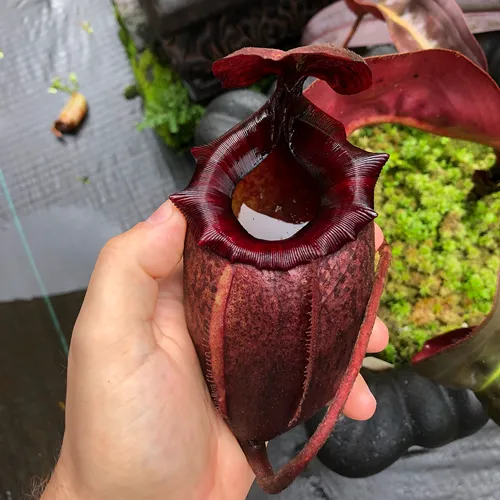 86. N. rajah x peltata Red Phantom, aka N. Leviathan, by Red Lowii
86. N. rajah x peltata Red Phantom, aka N. Leviathan, by Red Lowii 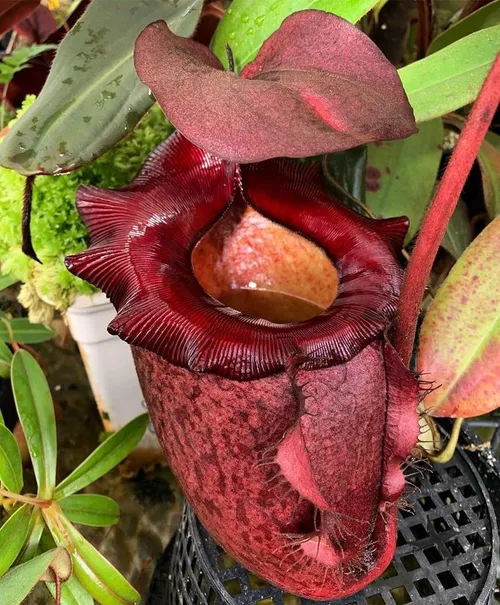 87. N. rajah x peltata Red Phantom, aka N. Leviathan, by Jeremiah Harris
87. N. rajah x peltata Red Phantom, aka N. Leviathan, by Jeremiah Harris Nepenthes truncata x peltata
Shinya Yamada has bred N. truncata with N. peltata.
Click on any photo to zoom in. Use arrow keys or swipe to navigate.
_%20by%20@studios_s_s.BLyf1HL-_2gU1Bw.webp) 88. N. truncata x peltata (likely Red Phantom), by @studios_s_s
88. N. truncata x peltata (likely Red Phantom), by @studios_s_s _%20by%20@studios_s_s.Cd94yCPs_1oyhfz.webp) 89. N. truncata x peltata (likely Red Phantom), by @studios_s_s
89. N. truncata x peltata (likely Red Phantom), by @studios_s_s Huge thanks to Francis for putting this article together. Be sure to give him a follow on Instagram - fbauzonx and peltata_man69.
